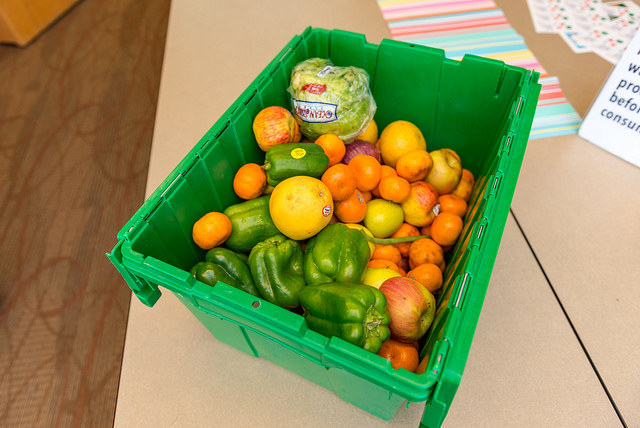 Fruits and vegetables are part of a balanced diet, but incorporating them into your regular routine can be challenging. Here are some tips and tricks to help you add more fruits and vegetables to your day while saving money and time.
Fruits and vegetables are part of a balanced diet, but incorporating them into your regular routine can be challenging. Here are some tips and tricks to help you add more fruits and vegetables to your day while saving money and time.
Maximize Your Produce Dollars
Money can be tight as a student, but that doesn’t mean you shouldn’t have access to nutrient dense foods like fruits and vegetables. Knowing where to get produce can be a game changer in helping you increase your fruit and vegetable consumption. Check out some of our favorite places to access produce on and around campus:
- Programs that stretch your grocery budget
Did you know that you have access to free produce on campus at Fruit and Veggie Up? You can pick up free, seasonal produce sourced from local grocery stores and farms right on campus. Check the current schedule on the Aggie Compass website.
The Pantry can provide up to three items a day for UC Davis students who show a UC Davis identification card. You can choose from a variety of food items and common personal items.
The CalFresh Program, a federally sponsored program known as the Supplemental Nutrition Assistance Program (SNAP), can add to your food budget. The program issues monthly electronic benefits that can be used to buy most foods at many markets and food stores. You can meet with a CalFresh Enrollment Counselor on campus at the Aggie Compass.
- Grocery stores
Supermarkets have weekly sales that can save you a lot of money. Check online for special deals before you go to the store and write a list of the items you want to buy. Specifically, look for sales on frozen and canned produce. If something you don’t normally buy is on sale, be flexible and try something new. Who knows, you just might like it!
Try buying produce in bulk with a friend or roommates and split the cost—as they say, sharing is caring.
If you sign up for a free grocery store card, the points add up and you can receive items on sale every time you go, or can receive coupons and discounts for a later time.
- Farmer’s markets
The UC Davis Farmer’s Market is held every Wednesday during fall and spring quarters from 11 a.m. to 1:30 p.m. on the Quad. You can find fresh produce right on campus, so you don’t have to spend time or money on transportation to a store!
The Davis Farmers Market is on Wednesday evenings and Saturday mornings at Central Park (4th and C Street). Check out the schedule for times. This is a great opportunity to buy fruits and vegetables and ask the farmers how to prepare them. The farmers market accepts EBT and participates in the Market Match program, which allows you to use your CalFresh benefits at the market.
- Gardening and campus gardens
You can reduce your spending by growing your own herbs, vegetables and fruits.
Not sure how to garden? You can learn right on campus! Check out the Student Farm’s website to learn more about opportunities on campus to dig your hands in the dirt.
Use the edible campus website to find forager friendly areas to pick fruits and veggies.
There are many places to grab free or discounted produce on and around campus. Check out the Food Access Map to see all the locations in Davis.
Tips to Eat More Fruits and Veggies
Incorporating small changes throughout the day can make eating more servings of fruits and vegetables more doable. If you’d like to eat more fruits and vegetables, you can:
Add fruits and vegetables to whatever you are already eating. If you already make pasta for dinner, then add some vegetables like frozen broccoli and bell peppers. If you eat yogurt for breakfast, try flavoring it with fruit like bananas or berries. If you get a burrito, load it with lettuce, salsa and any other vegetables available.
Include a fruit and/or vegetable with your meal. For example, If you are ordering a sandwich at the CoHo, you can ask for extra vegetables on the sandwich and choose an apple or orange as your side.
Prep your fruit and vegetables at the beginning of the week so they are ready when you need them.
Take a cooking class at the Student Health and Wellness Center for hands-on experience preparing fruits and vegetables along with other budget-friendly foods.
Understand what one serving looks like. Since fruits and vegetables come in various shapes and sizes, this visual representation shows you what exactly one serving looks like.
Keep fruits and vegetables in sight! You are more likely to consume them if you can see them.
Tips for Using Frozen Fruit and Vegetables
A study published by UC Davis researchers reported that canned or frozen fruits and vegetables have similar and sometimes higher nutritional value than fresh fruits and veggies. The key to using frozen fruits and veggies is knowing the best method to prepare them to optimize the taste and texture. Here’s a guide to using frozen and canned fruits and veggies:
- Canned Corn
- High in fiber and important digestive nutrients, canned corn is very versatile. Toss ¾ of a cup (about as much as one fresh ear of corn) into a stir-fry or over some rice. It is also great in a bowl of savory oatmeal sprinkled with some salt and pepper.
- Canned Beans
- Anyone who has ever tried to cook raw beans knows that it is surprisingly time consuming, but beans are far too rich in fiber and protein to not include in our diet! Buying canned beans is a convenient and affordable choice. They can easily be mixed into a soup or added to tacos and salads.
- Frozen Bell Peppers
- Antioxidants and anti-inflammatory vitamins like vitamin A? Definitely. The satisfaction of that crisp vegetable crunch? Not so much. Frozen bell peppers don’t have the same crunch as fresh ones, but they are still delicious in cooked dishes like soups, omelets and pasta.
- Frozen Cauliflower
- Adding cauliflower, rich in Vitamin C and phytonutrients, is an excellent way to boost your immune function. You can quickly microwave frozen cauliflower and roast or toast it to add crunch.Frozen Cauliflower
- Frozen Broccoli
- Eating frozen broccoli will ensure you get your vitamins A, B and C. For a quick weekday dinner, add the frozen florets to Top Ramen while cooking it. It’s also quite tasty when you put it mac ‘n cheese!
- Canned Tomatoes
- Canned tomatoes can be used in many classic recipes, and they won’t rot quickly like fresh tomatoes. Add spices to pureed, canned tomatoes for a homemade pasta or pizza sauce. If you feel like baked chicken can taste a little dry, put canned tomatoes on top of the chicken cutlets to juice it up!
- Frozen Berries
- Frozen blueberries, raspberries and strawberries have a plethora of health benefits, and the best part is, they can also satisfy a sweet tooth. Make a refreshing smoothie, add berries to yogurt or warm up with some fruity oats—the options are endless!
- Canned Pumpkin Puree
- Pumpkins don’t have to be exclusive to fall. Enjoy a pumpkin pie smoothie by combining pumpkin puree, frozen bananas, yogurt, cinnamon and nutmeg. Warmer alternatives would include making a soup with pumpkin puree or mixing pumpkin into oatmeal for an extra creamy vitamin A boost.
- Frozen Spinach
- Popeye didn’t eat strictly spinach for no reason—it’s a nutrient powerhouse. For a delicious balanced meal, add frozen spinach to pasta with your favorite sauce and source of protein. Along with many of the other frozen fruits and veggies, frozen spinach can be pleasantly disguised in a smoothie.
- Frozen Peas
- What makes peas unique from other vegetables is their high protein content. For example, a 1/2 cup of cooked carrots has only 1 gram of protein, while 1/2 cup of peas contains four times that amount. They contain just about every vitamin and mineral you need, in addition to a significant amount of fiber. Peas can be an addition to almost any dish because of their mild flavor and berry-like shape. You name it! Try adding them to scrambled eggs, oatmeal, stir-fry, stew and pasta.
